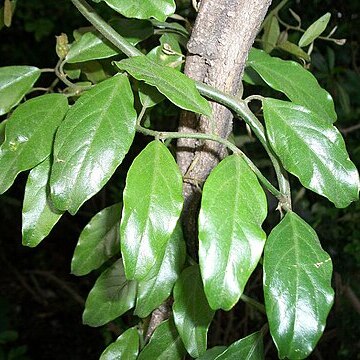Scrambling shrub, up to 3–4 m. tall, sometimes with branches to 10 m. long.. Twigs densely appressed-pubescent, at least when young.. Leaves petiolate; blade generally narrowly lanceolate or elliptic, sometimes broadly so, 0.7–6 cm. long, 0.4–3.2 cm. wide, rounded, emarginate, sometimes mucronulate, cuneate, rounded or subcordate at the base, rather thick, appressed-pubescent or rarely subglabrous; petiole 3–7 mm. long.. Flowers in few–many-flowered axillary fascicles; pedicels 5–30 mm. long.. Sepals 3–5 mm. long, pubescent.. Petals 4–7 mm. long, glabrous or pubescent.. Stamens 5–21; filaments 2–10 mm. long.. Gynophore about as long as the stamens; ovary ovoid, attenuate above.. Fruits subglobose or irregular in shape when dried, up to 2 cm. in diameter, orange or red, 1–several-seeded.
Climber or scrambler, height variable; branches long, slender, pubescent, becoming glabrous; spines recurved. Leaves alternate, spirally arranged, petiolate, puberulous to glabrous, narrowly elliptic or elliptic-lanceolate, bluntly pointed, often emarginate, margins undulate or crisped. Inflorescence axillary corymbs, pedicellate. Sepals broadly obovate, glabrous. Petals obovate to oblong, slightly falcate. Stamens 20-30 in male flowers, ± 10 in bisexual flowers; filaments often with long hairs. Ovary ovoid; stigma papillose, capitate, almost sessile. Flowering time all year. Fruit a spherical berry, orange-brown, glabrous.
A shrub or small tree. It grows to 7 m high. It can be scrambling. The stem has small hooks. The leaves are narrow and oval. They are 4 cm long by 1.5 cm wide. The flowers are in compact clusters at the ends of branches and in the axils of leaves. The fruit are round and 1.2 cm across. They are purple-black when ripe.


